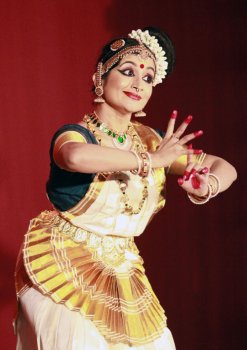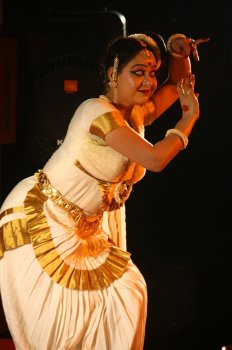
|   |

|   |
Facets of the woman - Padma Jayaraj, Thrissur e-mail: padmajayaraj@gmail.com December 26, 2012 The classical arts of Kerala are well-known. Koodiyattam, the Sanskrit theatre of Kerala is recognized by UNESCO as a “masterpiece of the oral and intangible heritage of humanity.” If Kathakali is the perfect classical drama of Kerala, performed by males, Mohiniattam is the female dance recital in solo performances. Although its origin dates back to 16th c, it is Swathi Thirunal who brought it to centrestage. The Malayalam poet Vallathol, founder of Kerala Kalamandalam, perfected and popularized this art form as an ethnic classical dance of Kerala in 20th c. Today, it is one of the eight Indian classical dance forms recognized by the Sangeet Natak Akademi. Kerala Sangeet Natak Akademi has taken it as its duty to give special stimulus to this exclusive dance form of Kerala by taking it to different parts of the cultural world. Its annual program ‘Mohini Nrityathi’ was staged as a 3 day session of Mohiniattam recitals in Thrissur, the cultural capital of Kerala from 6th to 8th Dec 2012. Mohiniattam, as the term suggests, is the ‘dance of the enchantress.’ In modern times there is a change in its connotations with themes other than love and devotion taken up by dancers who are thinkers. But still, it is the dance of the beautiful lady, highlighting the feminine aspects. The last day saw two performers presenting different facets of the woman’s persona in two solo recitals. Thematically the two recitals represent the growth of Mohiniattam from margam to innovative presentation; the venue shifts from ethnic Kerala to the pan Indian stage. Usha Suresh Balaje, a disciple of Kalamandalm Kshemavathi, presented the margam, starting with Cholkettu, a sinuous display of nritta, dressed in traditional costume to the accompaniment of traditional singing style and percussions exclusive to Kerala, although recorded for economic reasons. The stage setting that recalled koothambalam, the theatre complex of Kerala temples, in enveloping dusk was a beautiful ambience for the open air theatre. The Cholkettu was a perfect mood-inducing piece, choreographed by Kshemavathi, set to music by Vayala Rajendran in ragamalika and talamalika which was a vandanam in essence. The second item was a poem by the Malayalam poet Sugatha Kumari. The refrain in the poem is, ‘Krishna, you do not know me…’ because she lives in the margins of Vrindavan. Unknown and unseen, she worships Krishna shut within her hut. Being a lowly woman, she does not venture out flaunting her gorgeous dress, and jingling her anklets as others do. She dare not look at Krishna with longing eyes filled with love yearning to be embraced. Yet she worships him in the secret of her heart pouring her soul to light the lamp within. But to her surprise, one day Krishna stopped his chariot in front of her house, looked into her eyes, with eyes full of tenderness. “Oh! Krishna, you do know me!” She couldn’t believe her eyes. A touching poem with a mystical level was narrated in all simplicity. It was followed by an oft performed Swathi kriti, Krishna and Radha, young lovers frolicking on the banks of Yamuna, in adi thal, raag Vrindavana sarangi. The theme moved on from secret yearning to romantic love and then to the emotion of vatsalya, a mother’s tender love epitomized in the famous lullaby “Omana thingal Kidavo” written by Irayimman Thampi dedicated to baby Prince Swathi Thirunal. Raag Kurinji accompanied by mishrachapu taal endeared the presentation. Choreographed by Kshemavati, the recital had the beauty of simplicity, like the dancer herself. It was a comeback for Usha, an established dancer, after a long break.  Usha Suresh Balaje  Ayswaria Wariar Shakuntala is a solo item of 45 minutes, choreographed and performed by Ayswaria Wariar. Kalidasa’s immortal heroine shorn of mythical trappings transcends to a changeless realm. Using a Sanskrit script adapted by Dr. K.S. Bindusree, in the musical waves of sopana sangeetham (N.N. Sivaprasad), Shakuntala relives the pangs of womanhood cheated in love. The narration starts from the dramatic moment of rejection by King Dushyanta. It is a question of proof. The only proof that Shakuntala had is lost. The situation makes the theme contemporary and historical for women down the line. It is a moral dilemma as well, for a woman who leaves her father’s home only to know that there is no husband now. Shakuntala shivers in the cold of Hemandha on the portals of the palace. Shattered by the sense of loss the past flashes across her mind: her blissful days in Kanwashram as a maiden. How the warmth of Greeshmam enveloped her in love and affection. And how playing in ponds with her two friends was so exhilarating! Shakuntala is conceived as Nature herself, swayed by changing seasons. The idea that the sole function of nature is to sustain life underscores the woman’s qualities. Each scene that flashes through her reminiscence is associated with a particular ritu punctuated with the haunting refrain, “Pavithraya tham vasudhe…vasudhe…” When Vasantham brought the scented blossoms, Dushyanta crossed the Lakshman rekha of her maidenhood in the ashram. The charming scene of love at first sight both for the man and woman is aesthetically pictured. Also the use of pure dance numbers to indicate the sway of passion is a superb attempt. The romance painted against the beauty of Spring reminiscent of the paintings of Raja Ravi Varma has a touch of classicism. Gaandharva as a marital rite for personal sanctity is inescapable. And the separation …. oh! “Pavithraya tham vasudhe…vasudhe…” In Sisira, when all the leaves fall off, she recalls how she had prayed to her foster father not to uproot her from his heart. Yet there is no point of return for a journey, any journey. When Dushyantha questions her motive, anger swells in her heart. It is not just disowning but insulting her character by a man who has no character, who wants proof. The pronouncement comes like a bolt from the blue, “Anaarya…” is the climax of the presentation. The resolve to go on, no matter what, the steely resolve to raise her child ends in a prayer to Mother Earth, mother goddess immanent in the panchabhuthas. Like Sita, it is Mother Earth who is the refuge for the forsaken. Ayswarya uses the native thalas like the panchari and chempa to highlight emotional dilemma and conflicting thoughts in the Kerala singing style. Yet, the two Mohiniattam recitals point to the grandeur of the margam. To present a theme the need to resort to abhinaya dominates. The flavor of Mohiniattam lies in its mood creating lasya bhava. When a margam presentation is a dance recital, a theme-based performance tends to be a dance drama. ‘Shakuntala,’ because of its Sanskrit slokas tended to be an exclusive program for an exclusive audience in Kerala where the margam cast in Malayalam had an added charm for the lay audience. Perhaps, based in Vadodara, Gujarat, Ayswaria has a pan-Indian audience to address. She has given subtle touches to the costume as well to suit the ornaments of flowers in an ashram. Both the recitals were complimentary in function which also delineates the growth of Mohiniattam in the future years to come. Padma Jayaraj is a freelance writer on the arts and travel. She is a regular contributor to narthaki.com |